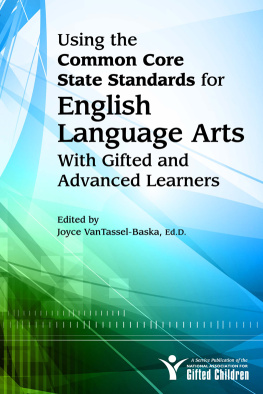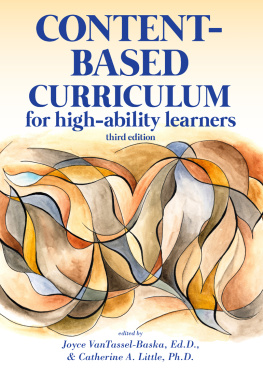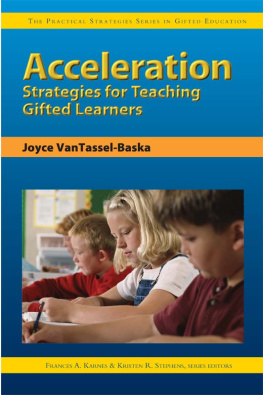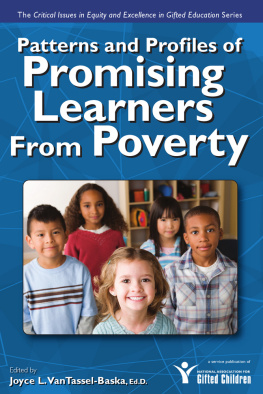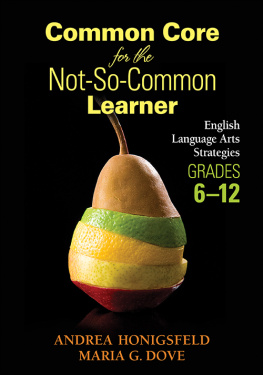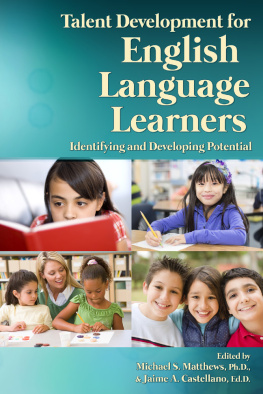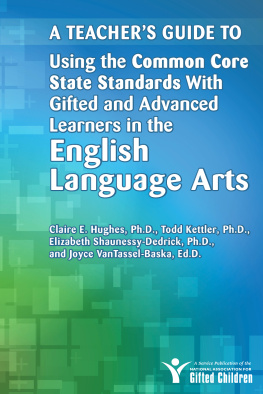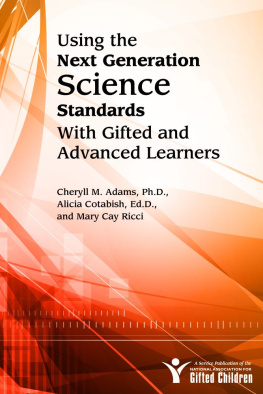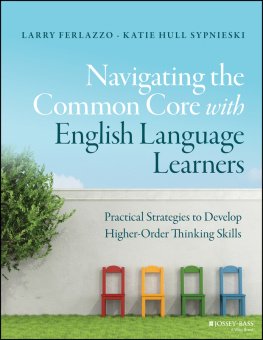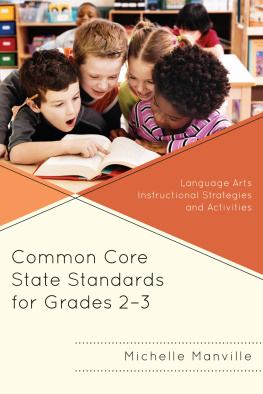Copyright 2013 National Association for Gifted Children
Edited by Jennifer Robins
Production design by Raquel Trevino
ISBN-13: 978-1-61821-042-5
No part of this book may be reproduced, translated, stored in a retrieval system, or transmitted, in any form or by any means, electronic, mechanical, photocopying, microfilming, recording, or otherwise, without written permission from the publisher.
At the time of this books publication, all facts and figures cited are the most current available. All telephone numbers, addresses, and website URLs are accurate and active. All publications, organizations, websites, and other resources exist as described in the book, and all have been verified. The editor and Prufrock Press Inc. make no warranty or guarantee concerning the information and materials given out by organizations or content found at websites, and we are not responsible for any changes that occur after this books publication. If you find an error, please contact Prufrock Press Inc.
 | Prufrock Press Inc.
P.O. Box 8813
Waco, TX 76714-8813
Phone: (800) 998-2208
Fax: (800) 240-0333
http://www.prufrock.com |
Foreword
In the fall of 2011, at the annual retreat of the Board of Directors of the National Association for Gifted Children, an urgent request for guidance about the Common Core State Standards (CCSS) and their relationship to gifted programming and curriculum was heard from every corner of the membership. NAGC leaders and experts responded, starting with a meeting of the NAGC Association Editor, co-chairs of the Professional Standards Committee, the chair of the Education Committee, and the NAGC President and Executive Director at the 2011 annual convention in New Orleans. An ambitious plan was developed to address the needs of gifted education specialists and teachers regarding how to integrate the CCSS with their current programming and curricula.
Out of that meeting came the idea to develop two booklets, one on the English language arts standards and one on the mathematics standards. All involved shared a heartfelt sense of urgency about the importance of this task. The Professional Standards Committee went to work immediately, spending evenings at the conference crafting initial informational materials on the CCSS to distribute via the NAGC website.
The Common Core State Standards are a significant milestone affecting education in the United States. As of this printing, 45 states have adopted the CCSS, attesting to the collective concern about the quality of education in our nation and the commitment to improve it. The CCSS embody significantly higher expectations for learning and thus, if implemented with fidelity, have the potential to dramatically alter achievement for all students.
Gifted educators are excited about the CCSS, as they reflect many of the strategies that the field of gifted education has been stressing for decades as important to deep learning and engagement and high achievementhigh-level, analytical thinking and advanced problem-solving skills. However, the CCSS alone will not ensure that gifted children receive the advanced content, accelerative options, and high-level enrichment that they need to be challenged and make continuous progress in their areas of talent. Hence the need for these booklets: They will help educators understand how to use the CCSS as a foundation and go beyond them for those learners who meet the standards earlier and faster. The booklets also assist educators in coupling and integrating the CCSS with gifted education curricula, instructional practices, and program models. These booklets are a valuable resource for all educators, not just those who work specifically in gifted programs. The reality is that most gifted children receive their instruction from teachers in heterogeneous classrooms, and these booklets can help all educators differentiate content and instruction for high-ability learners.
I want to thank the members of the Professional Standards Committee and others, who worked diligently to respond so quickly to the needs expressed by NAGC members and to fast track the production of these booklets through their efforts in New Orleans and at a work weekend in February 2012, particularly co-chairs Joyce VanTassel-Baska and Susan Johnsen, Cheryll Adams, Rima Binder, Alicia Cotabish, Reva Friedman-Nimz, Claire Hughes, Jennifer Jolly, Bill Keilty, Todd Kettler, Wayne Lord, Chrystyna Mursky, Julia Roberts, Elizabeth Shaunessy, Linda Sheffield, and Debra Troxclair. I also want to thank the NAGC staff members who edited and assisted with the production aspects of this project, especially Jane Clarenbach.
Paula Olszewski-Kubilius
NAGC President
20112013
Preface
The importance of strong curriculum in content areas for advanced learners is a basic consideration in all gifted programs nationwide. In no areas is this more needed than in English language arts and mathematics, as they constitute the cornerstones of learning in our schools at all stages of development. They also constitute important talent domains for the development of future professionals whose work is centered on the application of these subject areas.
Gifted education, through the National Association for Gifted Children (NAGC), has developed a set of curriculum, assessment, and learning environment standards for pre-Kgrade 12 programs that promote careful curriculum planning, differentiated instructional approaches, and authentic learning assessments, all aspects of the work associated with the new Common Core State Standards (CCSS). However, it was clear to the Professional Standards Committee within the organization that the Gifted Programming Standards needed to be aligned to the new Common Core State Standards to ensure that the CCSS are appropriately adapted and differentiated for our best learners.
The group has worked over the past several months to draft two guides (one in English language arts and one in mathematics) for practitioners that provide such translations for use in an array of settings that contain advanced learnersfrom cluster-grouped classrooms to pull-out programs to special classes to special schools. The guides provide examples of the relevant CCSS, matched to a suggested activity for typical learners and then differentiated for advanced learners. Assessment examples are also provided, including appropriate rubrics. Related material on further alignment to 21st century skills, to collaboration for interdisciplinary adaptations, and to professional development are included for easy referencing.
We sincerely hope these booklets will be used to ensure that advanced learners experience a rich and challenging curriculum as a result of the new CCSS and that practitioners use the examples as a model for their own continued curriculum work on behalf of advanced learners.
Joyce VanTassel-Baska, Ed.D., and Susan K. Johnsen, Ph.D.
Co-Chairs
Professional Standards Committee
National Association for Gifted Children
Acknowledgments
From concept to publication, there are a number of experts in English language arts, curriculum, pedagogy, and standards who volunteered their time and energy to support the development of this book. We value all of the contributions, but we would be remiss if we did not mention key participants from different stages of the books creation.
First, we acknowledge the leadership of NAGC president Paula Olszewski-Kubilius, who, in response to emerging calls for assistance from NAGC members, made this book a priority for the organization. We naturally turned to our colleagues on the NAGC Professional Standards Committee and other experts involved in gifted education standards for assistance. These volunteers helped develop the Common Core State Standards materials at the 2011 NAGC convention in New Orleans that provided an initial framework for these books.

